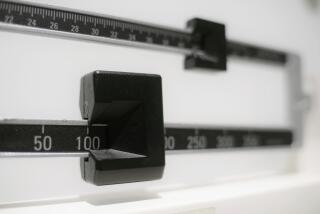Armband Monitors Fitness Goals
- Share via
Imagine a mini personal trainer strapped around your biceps as you work out at the gym or pull weeds in the yard. It counts the calories you burn and later relays the information to a software program on your computer to create a personalized plan of attack for your weight-loss goals.
Today’s workout technology goes beyond pedometers and heart-rate monitors.
Worn on the back of the upper arm, armband workout technology designed by companies such as Welnia in Florida and Apex Fitness Group (maker of the bodybugg) in California is becoming an increasingly common sight at fitness centers.
The armbands, essentially mini computers, are roughly the size of a standard MP3 player, with a bit more all-around bulk.
Four sensors touching the skin gauge everything from the effect of gravity and G-forces on physical exertion to the quality of your sleep to determine how many calories you burn. Ideally, the bands are worn all the time, removed only while swimming or bathing.
At least once a week, you download the information onto a computer, where you also must keep a detailed food log of everything you eat (software for the armbands includes extensive food catalogs for determining calorie counts).
The information then is processed to determine fitness and food recommendations designed to meet your goals, whether you’re trying to lose three pounds or 30.
“I play tennis every day, so I knew I was burning calories, but I couldn’t lose the weight,” says Nancy Miles, 51k.
Over the course of five weeks wearing the BodySense armband by Welnia and adjusting her diet and exercise according to its recommendations, Miles says she was able to lose seven pounds.
The feedback she received from wearing the band, she says, paired with her food logging, helped her realize that an active tennis schedule was helping her meet her calorie-burning goals during the week, but less-active weekends were keeping her from taking off the weight.
“It was really helpful to see when I am burning calories during the day, and when I’m not,” she says.
Miles says she liked the feedback from the Welnia program about her diet. For example, she learned from a bar graph on the food log that she wasn’t getting enough protein.
“It’s taught me to really think about what I’m eating and how often.”
She says she plans to wear the armband for several more months and hopes to lose an additional 12 pounds.
After one week of wearing the armband -- and regardless of whether a blood draw is incorporated into the program -- all Welnia users receive an 80-page report with information about their personal fitness and nutrition recommendations.
The armband and software alone, purchased as part of a six-month monitoring program from Welnia, costs between $350 and $700.
The bodybugg, also an armband, uses similar technology to help users reach their target weights. The cost is $399 for the armband and a three-month software subscription.
As with Welnia, the food-logging aspect is all-important for bodybugg users.
And although the bodybugg system does not offer the blood-draw option, it does include the optional purchase of a watch-like device with a digital monitor that lets you see how many calories you’re burning as you move.
“I think it makes a good tool for short-term use to get a handle on your caloric burn,” says Nicole Daniels, 35, an American Council on Exercise-certified personal trainer and lifestyle and weight-management consultant in Orlando. Daniels wore the bodybugg for one month as part of a trial program at an Orlando fitness center.
“It gives people motivation, looking at how many calories they burn,” says Daniels, adding that even she was surprised to see how the calories add up from daily activities such as walking the dog, washing the car and cleaning the house.




